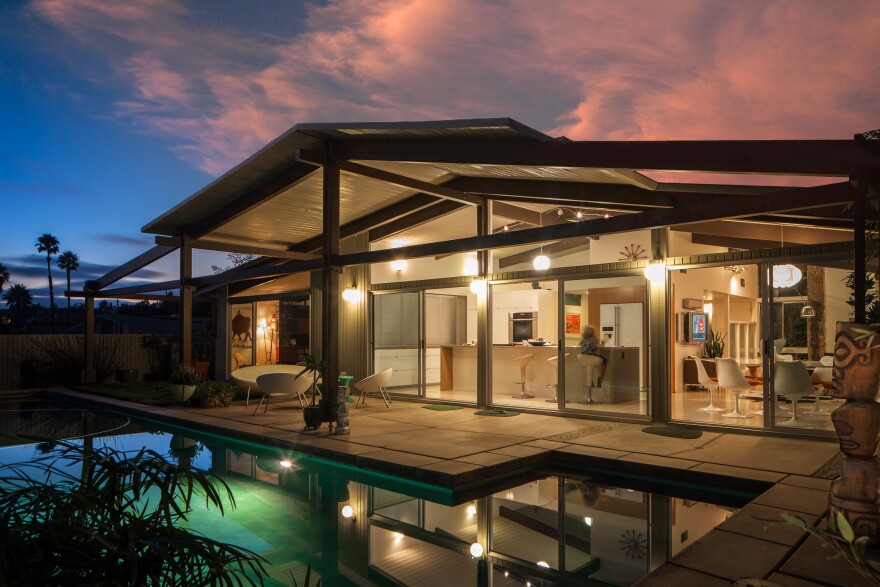When you think of tract homes, you think of houses that look the same: the same color scheme, the same style; homes that form two uninteresting walls on either side of a suburban street. That might be the case today, but nearly 60 years ago — at a time when "real" architects wouldn't touch tract homes — one architect did everything he could to break the monotony. His name is William Krisel, and he's being honored by a place whose look he helped define — Palm Springs, Calif.
The minute you see Krisel's homes, you're taken back to another era. They have distinctive angled roofs, high windows and desert color schemes with pops of rich gold or vibrant blue. They also have lots of glass and elegantly simple lines, a signature of all the houses in the city's Twin Palms tract neighborhood. One of those homes belongs to Heidi Creighton, and she knows just what she has. She says it's "a Krisel-designed home, and it would be classified as a Model A-3 sunflap flat-roof tract house."

Sitting in Creighton's living room, if you didn't see the flat screen TV, you'd swear it was 1962. The couch is angular and low to the ground. The wooden coffee table is kidney-shaped and rests on spindle legs. On an end table, there are glasses, a cocktail shaker and olive picks in their own stand.
"If you walked into my house," Creighton says, "you would see a light-infused, glass house with very little distinction between the inside and the outside of the house. Materials are simple, and you're happy to be here. It feels good."
In other words, it's consummate William Krisel. At 91, the architect himself lives in a condo in Beverly Hills with his wife of more than 60 years. Naturally, the condo is in a building he designed.
"At one point in my practice, of the 10 largest homebuilders in the United States, seven of the 10 were my clients," Krisel says. "And I have had built, from my designs, over 40,000 living units, and that's more than any other architect that I know of."

While his work is spread across the West, his Palm Springs houses proved that modernism could be livable and affordable. He notably designed several housing tracts for the Alexander Construction Co., which appreciated the way the homes could be built economically and with almost assembly-line efficiency.
Back in Twin Palms, around the corner from Heidi Creighton's house lives realtor Chris Menrad. Sitting poolside in the backyard of his agave-green house with a roof resembling the swoop of a check mark, he echoes Creighton's enthusiasm for the architect's design.
"There's a very big connection with the outdoors," Menrad says. "There's lots of windows, lots of clerestory windows, so you're always kind of looking up and out, and you're always aware of what's going on outside, or weather — sunlight."

Both Menrad and Creighton, who co-edited a new book on the architect, are picking up on the language of modernism. Like any language, Krisel says, it has basic tenets: "that a house is more than just a shelter; that it is a way of improving your way of life; that it can open up a whole new concept in your feeling every day; that the indoors and the outdoors are inseparable; and that the climate and the flora and fauna and ecology are all encompassed in making your decisions on how to create this space."
Krisel is also a landscape architect, so he had control over all design aspects. Plants were selected for shape and color; paint schemes and rooflines were varied so no two were too close together; and he varied the setbacks on each house to break the uninterrupted wall of homes found in most tract developments.

But despite this meticulous attention to detail, many still considered them just tract homes. "He was definitely sort of forgotten," Menrad says. In 1999, when Menrad began restoring his house, he was the exception. Now, Krisel says houses he designed throughout the Coachella Valley are being snapped up.
"One by one, I could find a house that somebody had restored properly, and then another one," he says. "And now it's like a virus. Everybody in Palm Springs wants to do it."
Actually, they've been fans for a while. For the past decade, the city has celebrated its architectural heritage during Modernism Week. At this year's event, it's renaming a street in honor of the once-overlooked 91-year-old architect.
Copyright 2016 KVCR


